Shot
Image Captured
Time Code
Length of Shot
Description of Shot
Annotation
1
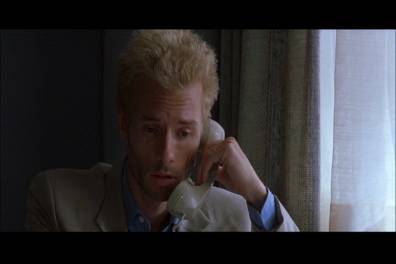
13:23
16 sec.
The scene begins with a static camera close-up on Lenny as he talks on the phone with Teddy. The only visible light is the dull white light that appears through the window’s curtain. The dialogue is heard over a repetitive, soft piano note. Lenny hangs up the phone and realizes that his left wrist has writing on it.
This scene begins after Lenny returns to his hotel room and tacks pictures onto the wall. He sorts through information that was given to him previously by Natalie, which reveals that the man he has pinned as Teddy is actually named John Gammel. He offers to visit Lenny, which will later (shown earlier in the film) lead to his death. Lenny is suspect about this chain of events. Why isn’t Teddy afraid that Lenny knows his real name and supposed past tribulations? Lenny seems unaffected by Teddy’s offer to visit, probably because he is used to unsuspected reactions due to his mental condition, which has been established as unable to form short-term memories.
1
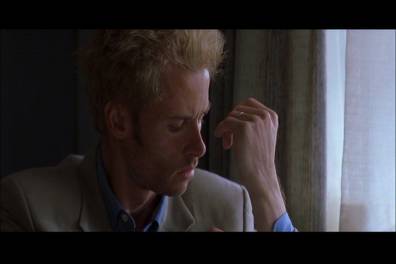
Continued
....
The camera remains static as Lenny leans in closely to the writing on his wrist, moving his cuff to expose it.
After he hangs up the phone, Lenny notices writing on his arm. Even his own tattoos appear strange to him since he can’t remember things from one moment to the next. The continuation of the phone call shot establishes the uncanniness of the momentary discovery of permanent writing that wasn’t there the moment before.
2
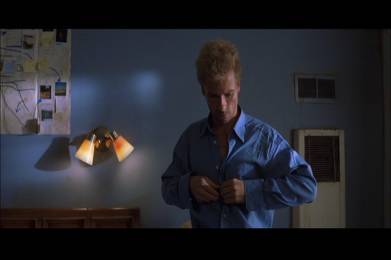
13:39
13 sec.
The camera cuts to a medium shot of Lenny standing, in the same small room, to remove his jacket and shirt. This shot is slightly brighter due to the artificial yellow light from a wall lamp behind him. The monophonic melody continues in the same tempo, picking up faint string instruments on a prolonged note. The camera slowly zooms out to reveal Lenny from the waist and above.
The camera moves back slightly for what is the longest possible establishing shot in the small hotel room. As he removes his shirt, the tattoos that cover his body become clearer. As a manner of speech, the wall lamp “sheds light on” his real project and motivation.
3
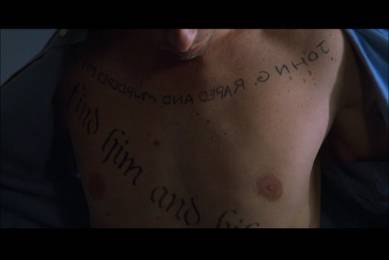
13:52
6 sec.
The camera cuts to a close-up of Lenny’s chest, more specifically his tattoos. The soft music continues.
The close-up following the establishing shot draws the viewer in to Lenny’s tattoos, which epitomize his motives and partially explains his previous (later) actions. Lenny’s personal motivations map the basic actions of his character and are explained succinctly by the tattoos on which he depends. Without these motivations, the story would lapse, lose its forward drive, and have no reason to continue. The textual summary of his character is extremely efficient, as would be a voice-over or intertitles, and more so than waiting for the character’s actions to explain themselves.
3
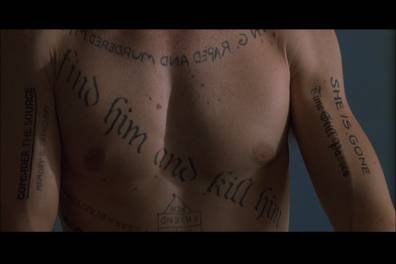
Continued
....
The camera tilts until the shot is entirely below his neck, and then remains static.
The gradual movement of the camera below Lenny’s head could be a depersonalization technique. Showing the body without the head creates a sense of one’s body with instinct and no logic or personality, which are typically associated with the brain (“losing one’s head”). Perhaps this is done to compare Lenny with a machine or computer who does not really act emotionally and is rebooted for the purpose of acting based on certain facts.
4
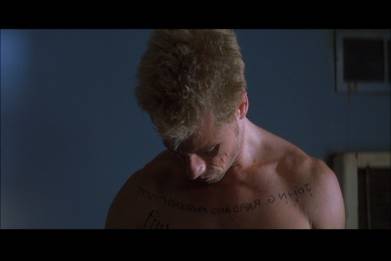
13:58
2 sec.
The camera cuts up to Lenny’s head, which is directed towards the tattoos that cover his body.
This is another establishing shot which shows Lenny looking at the area of his body that was shown in the previous shot. This is done to return to a dominant position and match the point of view shown in the later shots of his body. The constant images of words inscribed on his skin are a reminder of the dedication and character drive.
5
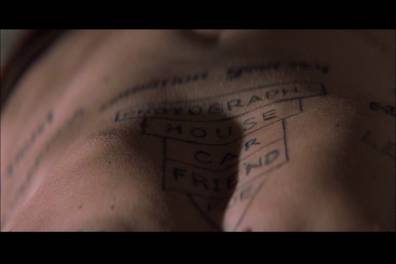
14:00
3 sec.
The camera cuts to an extreme close-up to match Lenny’s line of sight. The shot is still.
Following the previous establishing shot, this point of view shot serves not only to show the angle at which Leonard sees himself, but also to show his centered chest tattoo right-side up. This diagram, which is a possible indication of what he considers trustworthy begins with photograph, in which all his trust is invested. At different points in the movie it is revealed that his house and car are not really his, and that some of his friends aren’t even what they seem to be. Based on the totality of the movie, it is not unreasonable to assume that the “Foe” triangle is intentionally pointed up at himself.
6
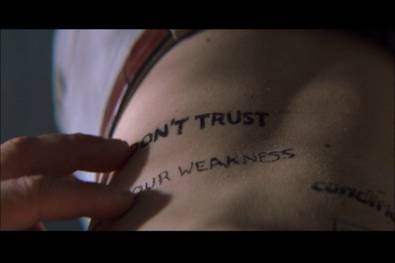
14:03
2 sec.
The camera cuts directly to another close-up, presumably looking at another tattoo and tracing it with his hand. There appears to be light coming in from the window in shot 1.
This other point of view shot shows the tattoo on his left side, which the viewer can assume is referring to his memory problems. To rely on his own memory is to fall victim to the same mistakes repeatedly and to open himself up to people that could potentially exploit his weakness.
7
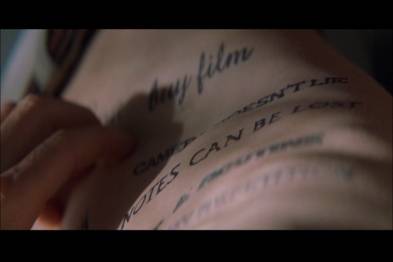
14:05
3 sec.
The camera cuts again (the 3rd time) for the same purpose. The music and style of the shot continue. The phrase “Buy Film” is shown centered, possibly as Nolan’s subliminal message to his audience.
The third point of view shot in this series shows the tattoos on Lenny’s right side, which are another series of reminders. The most important of which is probably “The camera doesn’t lie,” which serves not only to remind him of the permanence of the visual medium, but also the audience, who would find themselves in the same position as Leonard in piecing together the information of the film to draw conclusions. The reminder that notes can be lost is a unique one, in that it could be interpreted as a suggestion to avoid them or it could be seen as a suggestion for fabricating his experiences.
8
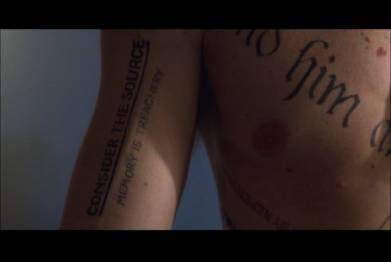
14:08
1 sec.
The camera cuts back to a close-up static shot facing Lenny, as opposed to the previous 3 shots from his point of view.
The camera has returned to an establishing position, once again to draw the viewer back to an objective standpoint while remaining focused on some of the tattoos that remain to be seen. Lenny metaphorically links memory with treachery, which is interesting considering that he purposely misleads himself later. The phrase “Consider the source” takes on a new meaning if the viewer knows that Lenny can’t trust himself. This is also important when he has two people each telling him that the other is not trustworthy.
9
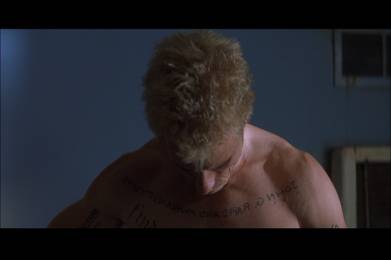
14:09
1 sec.
The camera cuts back to Lenny’s face as he continues to examine his tattoos. It begins to move down with the focus of his sight and action.
The camera returns to the origin of the exploration of his body. Every few shots, the camera must return to a semi-establishing position to maintain the viewer’s belief and ability to follow the visual progression.
10
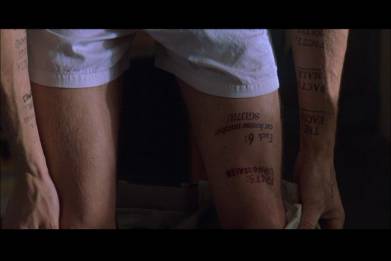
14:10
4 sec.
The camera cuts to a close-up of Lenny’s waist, and continues the downward movement of his pants lowering.
This shot is one of the few in which the camera moves, tracking Lenny’s vision and motion as he removes his pants and finds further writing on his body. It is a match on action with the previous shot, continuing the downward motion to create a smooth transition.
11

14:14
6 sec.
The camera cuts back to a close-up of Lenny’s upper body, raises as he stands upright, pans as he walks to the side-table, and lowers again as he sits. Shuffling papers are audible.
The camera goes back out to Lenny’s face, since he is determined in a new direction and a semi-establishing shot is required to redirect the scene’s movement. This time he moves back to the side-table to look at the papers that are in his files along with those that were given to him by Natalie. He must combine this information with the clues on his body, as he must every time he becomes conscious.
12
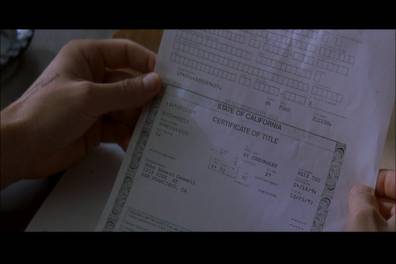
14:20
2 sec.
The camera cuts to Lenny’s point of view, a static shot with his line of sight is focused on the paper he picked up in shot 11.
This is another point of view shot now that the position and direction have been established. Lenny examines the paper for clues to match with his tattoos.
13
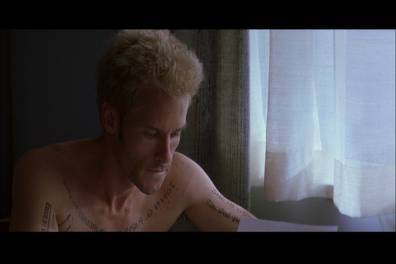
14:22
1 sec.
The camera cuts back to a close-up of Lenny reading the paper.
The camera cuts back to Lenny. This is a visual match, a reverse shot of the hands that were holding the paper.
14
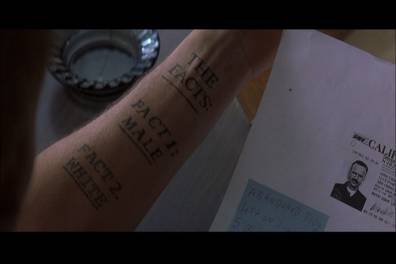
14:23
5 sec.
The camera cuts again to Lenny’s point of view, another sheet of paper. The camera pans left slowly as he compares the information on the paper with his arm.
The camera alternates back again to Lenny’s point of view (POV). Lenny only trusts photographs and himself, and must check the papers that Natalie has given him. This is an analog of the normal memory process wherein normally someone checks a fact or idea with thoughts or memories in their own mind. Since Lenny can not do this, writing clues on his body is his way of looking “into himself” to verify external information.
15
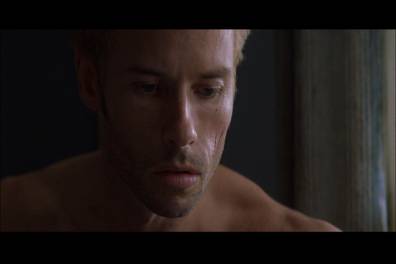
14:28
2 sec.
The camera cuts to an extreme close-up of Lenny. He mumbles the facts to himself.
The camera cuts back to an external shot of Lenny as he recites the information on the paper, processes it, and compares it to his tattoos. This verbal recognition of the information is also part of the economy of filmmaking, in which a character will recite facts in monologue that don’t necessarily need to be spoken out loud except for the viewer’s benefit.
16
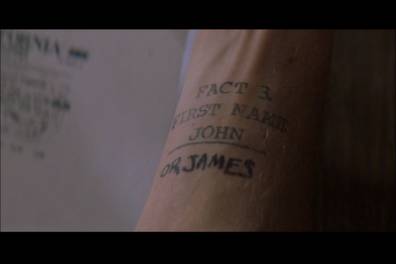
14:30
3 sec.
The camera cuts to an extreme close-up of his other wrist, assumably from Lenny’s point of view.
The alternation continues from a POV shot to an external shot. Lenny continues checking the different fact tattoos against his papers.
17
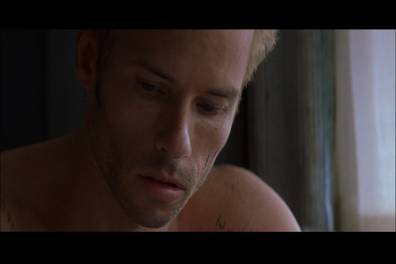
14:33
1 sec.
The camera cuts back to Lenny. He continues mumbling information to himself as he reads.
Alternates back to an external shot.
18
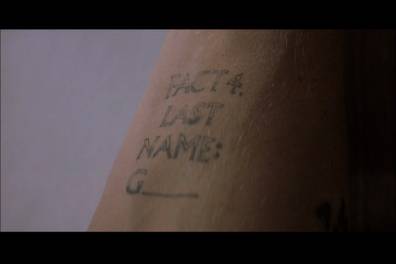
14:34
3 sec.
The camera cuts to Lenny’s arm again, just below the previous wrist shot. Lenny keeps reciting the information he is reading.
Back to a POV shot. Lenny keeps checking the paper against his facts, almost as a computer would by going through lines of code to produce a positive match.
19
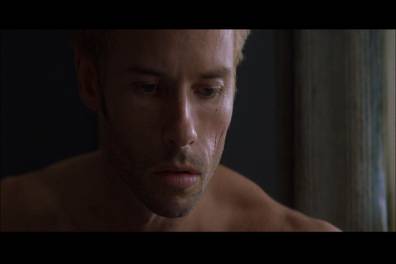
14:37
2 sec.
The camera cuts back to Lenny’s face the fourth time. The camera is motionless, and the light appears from the right side of the shot from an open window as in the previous shots.
External camera.
20
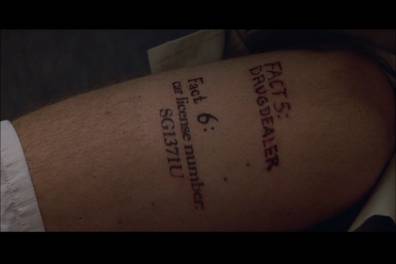
14:39
3 sec.
The camera cuts to Lenny’s back. Lenny moves his upper-body quickly and his thigh comes into focus.
POV shot.
21
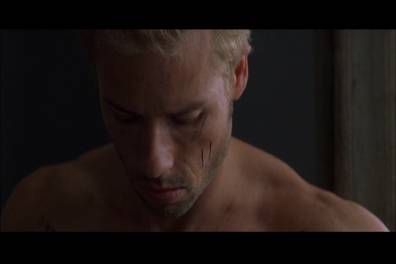
14:42
2 sec.
Lenny sees the tattoos on his leg and checks them with the original sheet of paper, reciting what he sees.
External shot. The pattern continues in a successive series to continue Lenny’s visual trail from himself to the outside information, but also to track the viewer’s similar progression.
22
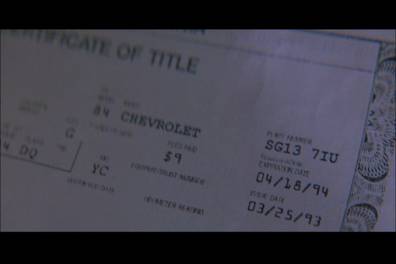
14:44
3 sec.
The camera cuts to an extreme close-up of the paper again as Lenny reads from it.
The shot returns to the title certificate from shot 12. This is the information that Lenny finds matching his sources.
23
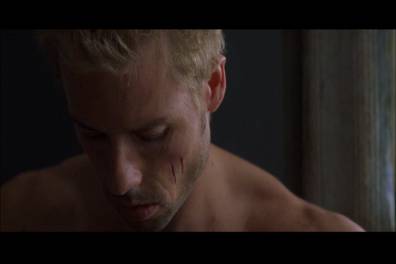
14:47
1 sec.
Cut to Lenny, who is reading the paper.
The camera cuts back to an external shot. Lenny responds to the information similar to a mechanical reaction by zeroing in on an anomaly and rechecking it to verify that he has found something.
24
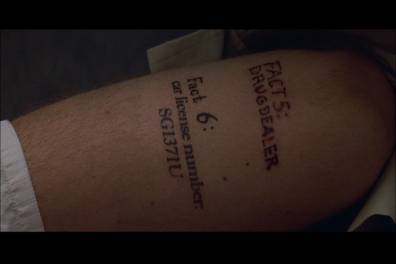
14:48
2 sec.
Cut to Lenny’s leg, with which he is cross-checking the automobile license sheet.
Lenny checks his leg again to verify the license plate number. Why does he only have two facts per limb? Is there any significance to him listing the facts from left to right and top to bottom on his arms and legs?
25
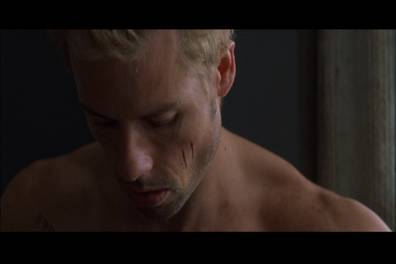
14:50
2 sec.
Cut to Lenny, who is reading the tattoo on his thigh.
Lenny who finally realizes that Teddy is the man he is looking for.
26
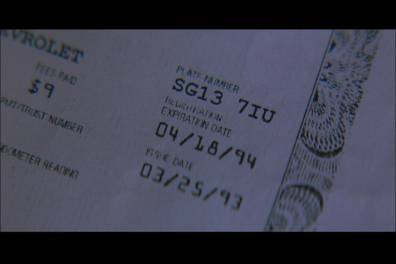
14:52
2 sec.
Cut back to an extreme close-up of the paper, which Lenny has noted as the same plate number that is tattooed on his leg.
Cutting back to the paper completes the sequence of shots between Lenny (A), his leg (B), and the paper (C). The series follows as ABACABAC.
27
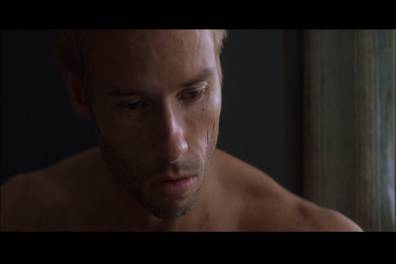
14:54
7 sec.
Cut to Lenny again, who mumbles to himself about realizing who he has been looking for.
Once again, Lenny comes to a verbal realization in the interest of telling the viewer what they have seen through the series of clue shots and establishing shots.
28
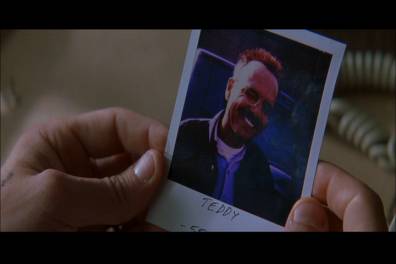
15:01
3 sec.
Cut to an extreme close-up of Lenny holding a picture of Teddy.
The picture provides an outlet for Lenny to direct his anger towards, and simultaneously exists as both a visual backup of previous knowledge and proof that this knowledge is meaningless. The photographs that he invests so much faith in have divested all outward blame towards themselves. They have misled him. Is it possible that he has misled himself by putting so much faith in them?
29
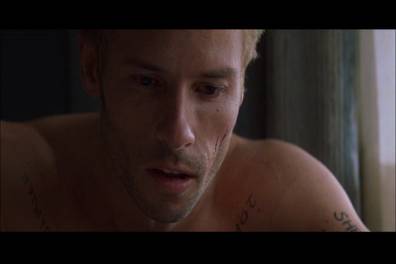
15:04
3 sec.
Cut to a reverse shot of Lenny, who is talking to the picture of Teddy.
Now aware that Teddy is the man he is looking for, Lenny speaks out at the photograph. Oddly enough, in the film’s progression, Lenny had already completed the act before he uttered it.
30
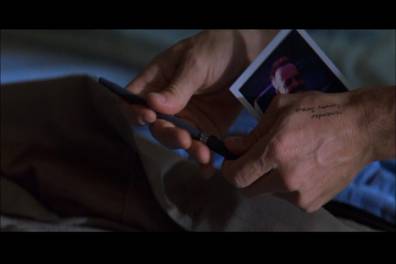
15:07
5 sec.
Cut to Lenny approaching his bed, taking out a pen, and beginning to write on the picture of Teddy.
Determined to not forget this realization about Teddy, Lenny goes to write it down. It is this occurrence that he will forget later (earlier) in an incident with Natalie, without which he would have never gotten her help in figuring out that Teddy was a “John G.”
31
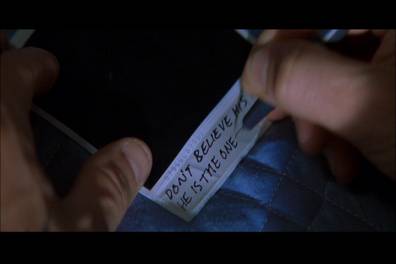
15:12
8 sec.
Cut to an extreme close-up of the writing.
This sort of close-up draws attention into the writing and also the process of writing, which in this case is used to resignify the picture that identifies things. A picture turns from friend to enemy simply from signification, which is arbitrary to Leonard based on his rules to trust certain proof more than other forms.
32
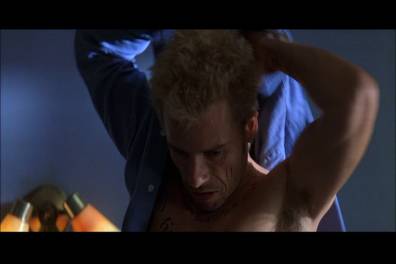
15:20
3 sec.
Cut to Lenny standing up and putting his shirt back on.
Lenny dresses himself in preparation for meeting Teddy, a meeting which the viewer already knows ends poorly.
33
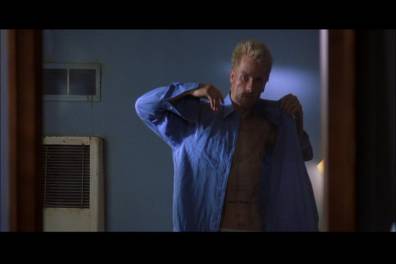
15:23
11 sec.
Cut to a similar medium shot of Lenny getting dressed taken through a mirror. Lenny approaches the mirror and realizes the backwards tattoo on his chest. The piano tones stop for the first time in the scene, but the string instruments remain.
Only through the mirror does Lenny realize the tattoo that he had not seen before due to its placement and style. The change in music detracts from the normal aspects of the situation and has the effect of an abrupt change, since it was continuous up until this point. This is especially true considering the circumstances of Lenny’s discovery. His chance vision of that tattoo causes, through a chain of events, Teddy’s death.
34
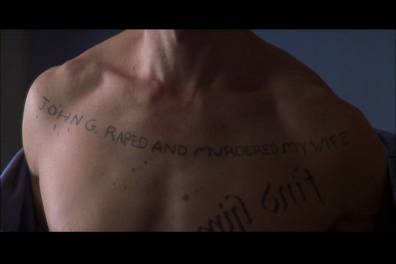
15:34
9 sec.
Cut to a close-up of Lenny’s chest tattoo, taken through a mirror’s reflection.
This close-up serves to highlight the importance of the tattoo and also the words that make it up. The tattoo is important because it encompasses his entire reason for being. Lenny’s experience in front of the mirror, most people’s place of self-identification, is a devastating fact. The placement of the tattoo in that way encapsulates his purpose. Also, the mention of his wife is what sets Leonard off, since her death is his last memory he takes vengeance on her behalf. Had the tattoo read “Kill John G. He deserves it,” would Leonard be as motivated?
35
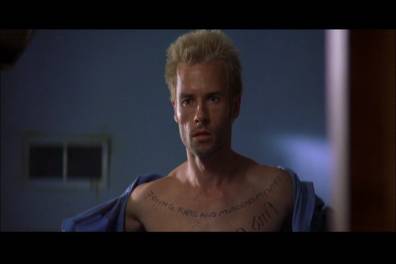
15:43
10 sec.
Cut back to a close-up of Lenny who stares at the tattoo momentarily and continues to put his shirt on. The camera tilts down slightly,
Lenny continues to put his shirt back on, similar to the manner in which he does it in shot 32, however the position and direction of the camera are still focused on the mirror tattoo in close-up. It is clear that he is preparing for a new purpose, to get revenge on Teddy rather than to confront him.
36
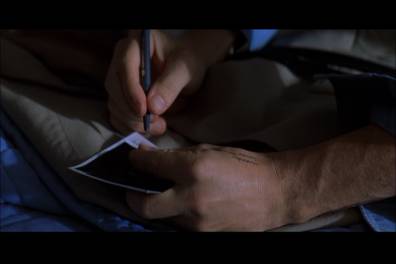
15:53
4 sec.
Cut to Lenny returning to his bed, taking out the pen, and writing on Teddy’s photograph again.
This shot mirrors number 30, but the repetition of writing along with the previous shots necessitates a stronger message.
37
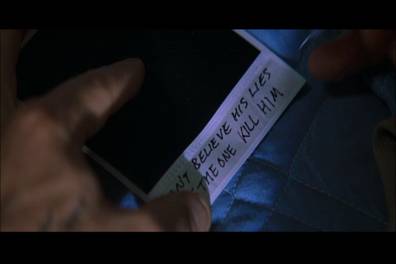
15:57
8 sec.
Cut to an extreme close-up of the writing.
Whereas the first direction on Teddy’s picture is Lenny’s advice to himself about talking to Teddy, and the second is a connection that Lenny draws, the third direction is a command to himself. Leonard also fills the back of Teddy’s photograph. There is no more room to write, Teddy has reached the end.
38
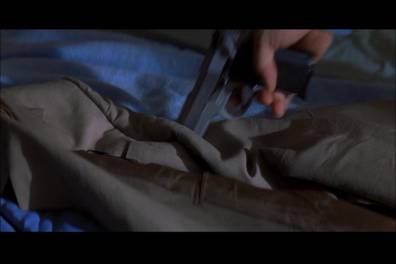
16:05
1 sec.
Cut to a close-up of Lenny grabbing a gun from the bed.
Action to accompany Lenny’s motives. The shot is faster than the others in an already quick-paced scene. This eagerness reflects Lenny’s intentions, and he has no second thoughts.
39
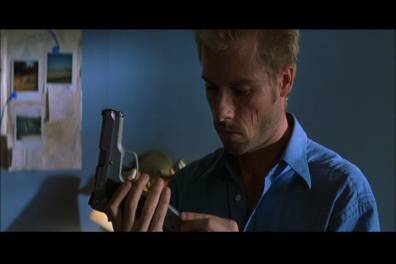
16:06
2 sec.
Cut to a close-up of Lenny putting a clip into the gun.
This is the second appearance of the gun, one which is necessitated by the previous (subsequent) scene where Lenny shoots Teddy. This type of appearance could be termed a retrospective establishing shot. It sets the scene for something that has already taken place, although it has yet to take place in the temporal order of reality.
40
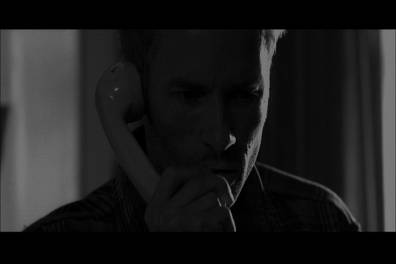
16:08
3 sec.
The camera cuts to black and fades into a close-up of Lenny on the phone (now shot in black and white). Lenny remarks that he doesn’t remember talking to that person. There is no more background music or noise, nor any direct light sources.
The cut to black followed by a fade-in is analogous to Lenny’s visual experience. His memory serves him well while he is awake, and his system and instincts almost make up for the rest. The gun from the previous scene is visually substituted by a telephone. Where the gun carried over the action from the first few scenes, the telephone extends the action into the next few and provides a bridge for the narrative. The change from color to black and white implies not only a change in time, but a change in situation (also obvious since the music, which was constant in the previous scene, has stopped). Lenny seems more capable, in both talking and acting. Perhaps this is because the scene begins far from a memory lapse and he has already regained his clues, or maybe because he is completely ignorant of them. He is, after all, “in the dark.”
41
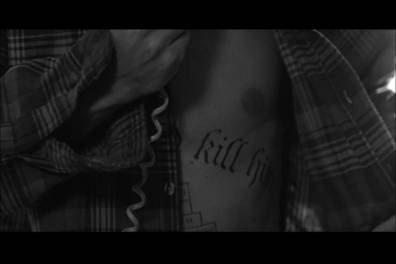
16:11
5 sec.
Cut to a close-up of his chest. The camera tilts down as he unbuttons his shirt. Lenny is heard saying that he can’t make new memories.
The establishing shot cuts to a sectional shot, which breaks down the previous idea. As he unbuttons his shirt, his tattoos becomes visible, and it becomes clear that he is already aware of them at this point. His insistence that he is unable to make new memories is a reinforcement of his previous encounters.
42
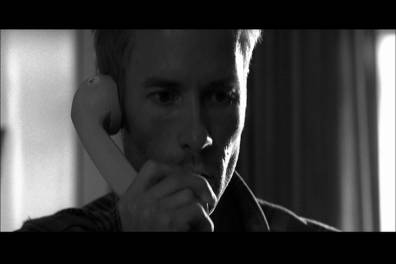
16:16
2 sec.
Cut to Lenny’s head again. Lenny asks the person on the phone what they last talked about.
The admission that Lenny doesn’t know what they last talked about brings the view back to an establishing shot (“back to square one”). He must begin again from where he is told that he left off.
43
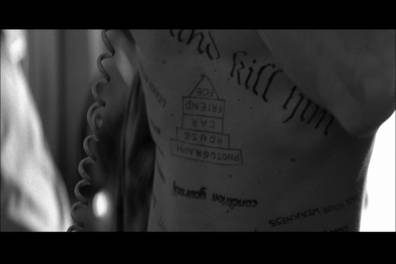
16:18
3 sec.
Cut to Lenny’s chest. Lenny responds that he had last talked to the person about Sammy Jankis.
Sammy Jankis serves a double purpose here. He becomes an allegory for Lenny’s situation while remaining a clue or key to Lenny himself. Simply by mentioning Sammy, Lenny enters into conversation and reveals the system of his memory over the phone.
44
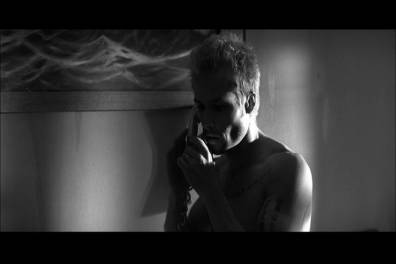
16:21
2 sec.
Cut to Lenny’s upper body in darkness, continuing his phone conversation.
The conversation continues. Lenny seems to be pacing back and forth around his room.
45
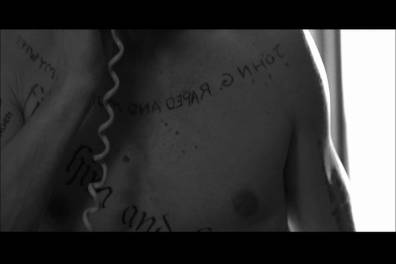
16:23
2 sec.
Cut to Lenny’s chest in close-up. Lenny says that Sammy’s story helps him understand his own situation.
Lenny talks about his similarities to Sammy. The receiver, which is presumably in his hand, and the base are both out of the frame here. Perhaps this is to show that Lenny does not know who he is, or who he is connecting to.
46
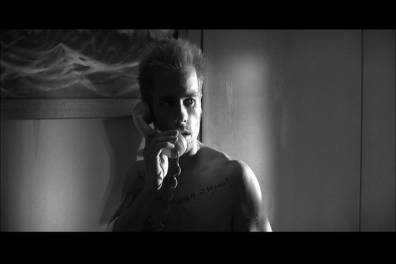
16:25
6 sec.
Cut back to Lenny. Lenny talks about Sammy’s system of leaving himself notes.
Lenny’s mention of Sammy leaving himself notes draws attention to the conspicuously absent board of notes that Lenny had for himself in the previous scene on a big interconnecting map.
47
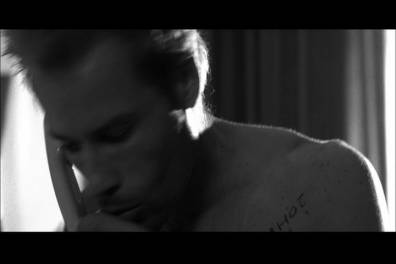
16:31
2 sec.
Cut to an extreme close-up of Lenny’s head moving down.
This shot transitions between Lenny’s phone conversation and his monologue.
48
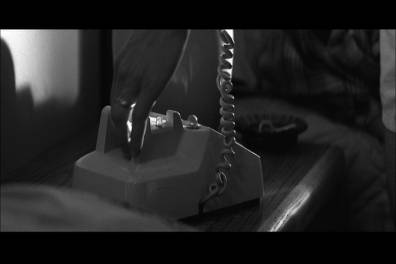
16:33
1 sec.
Cut to a close-up of Lenny grabbing the phone base.
Lenny picks up the phone and becomes mobile by doing so. Maybe he wishes to detach himself, freed from cords and constraints. Without his mental constraints he could find his wife’s killer.
49
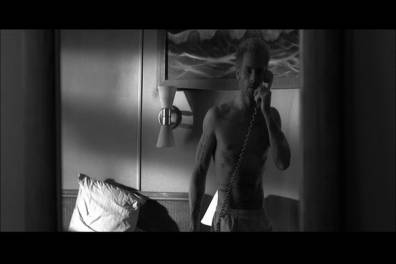
16:34
2 sec.
Cut to Lenny in a medium shot taken through the reflection of a mirror. Lenny starts to walk towards the mirror.
Lenny is talking on the phone, but also talking to his own image in the mirror. The viewer is reminded of how Lenny sees himself. His image is dominated by the looming desire to find John G, around which his purpose is based.
50
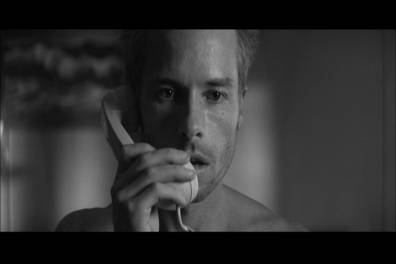
16:36
6 sec.
Cut to a close-up of Lenny’s face. Lenny talks about his use of habit and routine to make his life possible despite his memory problem.
Cut back to a straight shot of Lenny, not through the mirror. This amounts to a break of the system of continuity shots that has continued through the scene. By shooting Lenny through the mirror, and then straight on, the 180 degree rule appears to be broken (The phone is on his left, then right, then left again). This causes a feeling of perplexity, sometimes dizziness, and causes the viewer to come to notice the camera on top of the story. Lenny discusses Sammy while staring into the mirror. Is there a missing identification here?
51
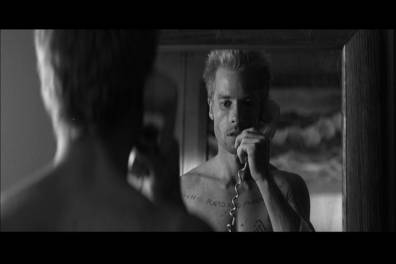
16:42
2 sec.
Cut to a close-up shot behind Lenny with his mirror image visible.
Cut again, this time with both Lenny and his mirror-image. Is he being doubled or is he someone else’s double. Once again he faces himself, which is reminiscent of looking at himself for an answer to his problems, looking to his tattoos for purpose.
52
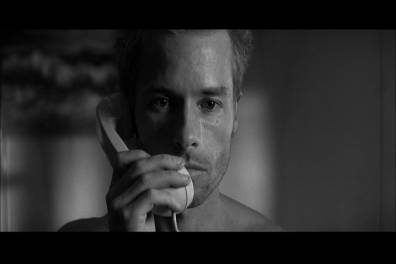
16:44
4 sec.
Cut to Lenny’s face, presumably staring at his mirror image. Lenny says that Sammy had no drive or reason to make his life work.
Lenny is staring at his mirror image. The difference between him and Sammy is that Lenny has purpose and drive. His drive necessitated the system of remembering, and he can’t look into the mirror without being reminded of his dead wife. Is he haunting himself with these facts?
53
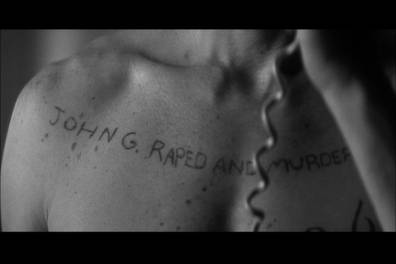
16:48
2 sec.
Cut to Lenny’s chest. The camera slowly pans right. Lenny says “Me? Yeah,” presumably in response to whether or not he has a reason to live.
Lenny’s response to the person he is talking to is an affirmation of identity as well as an answer to their question. If Lenny is facing the reason for his drive only when he is standing in front of a mirror, then doesn’t his drive lead him to himself?
53
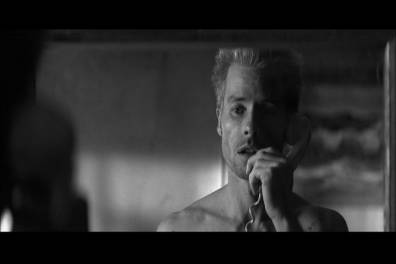
16:50
4 sec.
The camera cuts back to a close-up of Lenny’s face. Lenny says that he has a reason to live.
Lenny knows he has a reason to live, he knows he wants to find his wife’s killer. Is the memory of his wife driving him to kill or is the desire to have purpose driving him to kill?
53
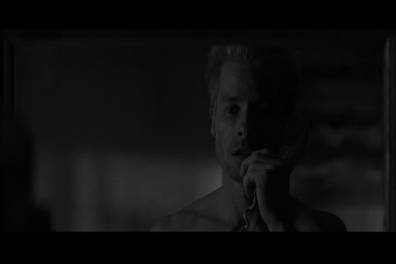
Continued
....
The camera fades to black. The phone conversation is assumed to be over.
This style of finishing out the scene translates to Lenny’s experience. The viewer fades to black, and the movie continues in another place and time. This is Lenny’s experience. Each scene is only a memento of his life, which is in turn only a memento of his wife.